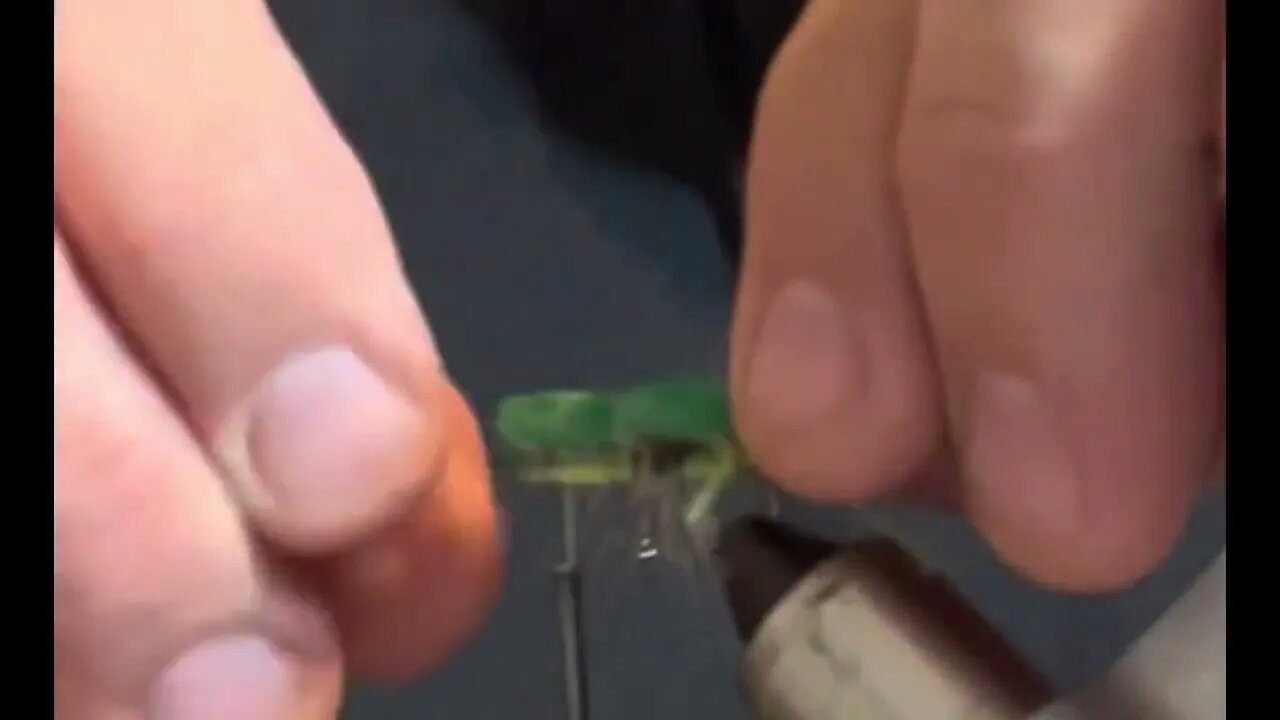Premium Only Content

#10 Beetle Lizard Fly Tying Tutorial
This super easy-to-tie Foam Beetle may not look like much but it's one of my favorite patterns for the late summer and early fall. Let it land with a splat beneath over-hanging vegetation, give it a little twitch or two and, if there's a fish there, chances are you'll get a take.
For a hook, a Dai-Riki #730 in size 14 is a good choice. For tying thread, don't be afraid to go a little heavy. Here I'm going to use black 140 Denier Ultra thread.
Get your thread started on the hook shank leaving some space behind the eye and take a few wraps rearward before snipping off the tag.
Standard black 2 millimeter craft foam is used to form the beetle's back and head. I've found that 1/4 inch widths are just about perfect and that a paper cutter produces nice, consistent strips. While you have it out, you might as well make a bunch. They may come in handy on a cricket pattern . . .
Lay one of the foam strips on top of the hook shank at the tie-in point and take a good firm wrap to anchor it. The foam will want to fight you a bit, but don't take "no" for an answer. You'll eventually get it under control. Take nice tight wraps that compress the foam all the way back to the start of the hook bend. Continue taking wraps up and back until most all of the foam on the hook shank is compressed. End with your thread back at the hook bend.
Although there are many materials you can use to represent the beetle's legs I really like the look of plain old black saddle hackle. Find a feather that isn't overly webby and has some good straight, stiff fibers. Snip off the base of the stem where the fluffy webby stuff begins, then strip about 1/2 an inch of fibers from both sides of the stem. Place it on the near side of the hook and secure it with several turns of tying thread.
For the beetle's undercarriage, the texture and iridescence of natural peacock herl just can't be beat. Pull 3 or 4 strands from the strung bundle and snip off about two inches of the brittle tips. Secure the herl to the hook shank as you did with the saddle hackle and end with your thread all the way back at the bend of the hook.
Leaving your thread in this position, get hold of the herls and begin making adjacent wraps up the hook shank, being careful not to break the them on the sharp hook point. The thread should hold the herls back and together as you wrap. When you reach bare hook shank, tie them off with 2 or 3 good wraps of tying thread. Then snip the excess herl off close. You can take a few more wraps of tying thread to cover the ends if needed.
With hackle pliers, get hold of the tip of the saddle hackle and begin making open spiral wraps over the peacock herl toward the hook eye. Three of four wraps should do it. Secure the hackle tip with three or so turns of tying thread and then snip it off close.
To avoid clogging the eye, sweep the hackle fibers rearward and take thread wraps to hold them back. Then preen the fibers that are sticking up, back and down before folding the foam over the back of the fly. Pull the foam forward and, while holding it securely, make 3 full wraps with your tying thread. Then, using a good bit of thread tension, take a few more tight wraps to really anchor the foam in place. Pick up your tying scissors and snip the foam off leaving about an 1/8th inch long head over the hook eye.
This beetle floats well but low in the water, making it difficult to see. A small sighter punched from a bright sheet of foam does wonders for increasing the fly's visibility. Tie the sighter in right where you left your tying thread. A few tight wraps are all that's needed. Get hold of your whip finish tool and do a 5 or 6 turn whip finish before snipping off the thread on the underside of the fly.
If you like, you can round the edges of the head off just a bit. Flip the beetle over and trim off all the hackle fibers that point straight down. They should be trimmed off flush with the peacock herl. You can leave the remaining fibers long but I think the fly looks better with them trimmed off fairly close.
Finally, apply a liberal amount of head cement to the thread wraps just behind the eye, being careful not to fill the eye with cement in the process. And that's all there is to making a simple foam beetle. They work well and are an absolute blast to fish.
-
 LIVE
LIVE
Right Side Broadcasting Network
4 hours agoLIVE: Karoline Leavitt Holds a White House Press Briefing - 4/15/25
8,120 watching -
 LIVE
LIVE
The Charlie Kirk Show
1 hour agoBury Harvard + Defund NPR + The "Maryland Dad" Lie | Vought, Davis, Kane | 4.15.25
3,851 watching -
 43:40
43:40
Winston Marshall
2 hours ago30 Politically Motivated Deaths in 2025 So Far…Tim Pool Uncovers Civil Strife in America
4.87K4 -
 LIVE
LIVE
Rebel News
39 minutes agoPoilievre on defunding CBC, Carney on climate change, PPC candidate's bank frozen | Rebel Roundup
578 watching -
 LIVE
LIVE
Flyover Conservatives
2 hours agoRUSSIAGATE: Steele Dossier was FAKE the Whole Time... and They Knew It! - Hans Mahncke | FOC Show
496 watching -
 LIVE
LIVE
TheAlecLaceShow
4 hours agoGuest: Mayor JD Longo | Bukele Visits Trump | Assassination Plots | Tax Day | The Alec Lace Show
49 watching -
 38:18
38:18
Grant Stinchfield
1 hour agoCDC Records Vanish: Top Vaccine Safety Administrator's Files Missing Amid Federal Probe
1.6K7 -
 1:02:25
1:02:25
Steven Crowder
4 hours ago🔴 Qatar: The Small Gulf State with Portentous Global Influence
207K135 -
 2:34:36
2:34:36
Tate Speech by Andrew Tate
9 hours agoEMERGENCY MEETING EPISODE 109 - KNIFE CRIME ON MARS
67.5K48 -
 1:06:19
1:06:19
The Rubin Report
2 hours agoTrump, Bukele & Bondi Relentlessly Drill Reporter w/ Facts About Deported Gang Member
27.4K25